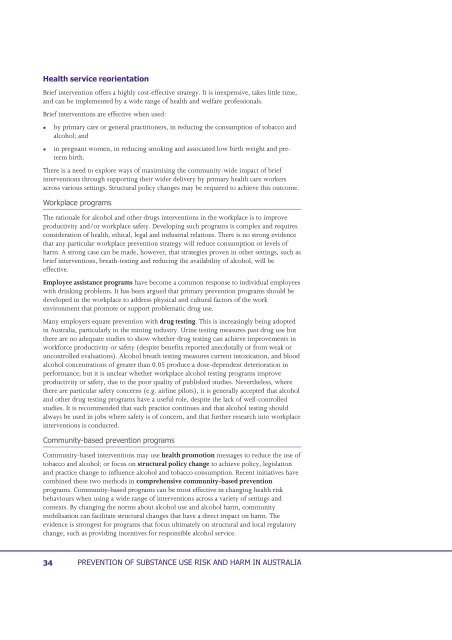Summary - Department of Health and Ageing
Summary - Department of Health and Ageing
Summary - Department of Health and Ageing
You also want an ePaper? Increase the reach of your titles
YUMPU automatically turns print PDFs into web optimized ePapers that Google loves.
Brief intervention <strong>of</strong>fers a highly cost-effective strategy. It is inexpensive, takes little time,<br />
<strong>and</strong> can be implemented by a wide range <strong>of</strong> health <strong>and</strong> welfare pr<strong>of</strong>essionals.<br />
Brief interventions are effective when used:<br />
by primary care or general practitioners, in reducing the consumption <strong>of</strong> tobacco <strong>and</strong><br />
alcohol; <strong>and</strong><br />
in pregnant women, in reducing smoking <strong>and</strong> associated low birth weight <strong>and</strong> preterm<br />
birth.<br />
There is a need to explore ways <strong>of</strong> maximising the community-wide impact <strong>of</strong> brief<br />
interventions through supporting their wider delivery by primary health care workers<br />
across various settings. Structural policy changes may be required to achieve this outcome.<br />
<br />
The rationale for alcohol <strong>and</strong> other drugs interventions in the workplace is to improve<br />
productivity <strong>and</strong>/or workplace safety. Developing such programs is complex <strong>and</strong> requires<br />
consideration <strong>of</strong> health, ethical, legal <strong>and</strong> industrial relations. There is no strong evidence<br />
that any particular workplace prevention strategy will reduce consumption or levels <strong>of</strong><br />
harm. A strong case can be made, however, that strategies proven in other settings, such as<br />
brief interventions, breath-testing <strong>and</strong> reducing the availability <strong>of</strong> alcohol, will be<br />
effective.<br />
Employee assistance programs have become a common response to individual employees<br />
with drinking problems. It has been argued that primary prevention programs should be<br />
developed in the workplace to address physical <strong>and</strong> cultural factors <strong>of</strong> the work<br />
environment that promote or support problematic drug use.<br />
Many employers equate prevention with drug testing. This is increasingly being adopted<br />
in Australia, particularly in the mining industry. Urine testing measures past drug use but<br />
there are no adequate studies to show whether drug testing can achieve improvements in<br />
workforce productivity or safety (despite benefits reported anecdotally or from weak or<br />
uncontrolled evaluations). Alcohol breath testing measures current intoxication, <strong>and</strong> blood<br />
alcohol concentrations <strong>of</strong> greater than 0.05 produce a dose-dependent deterioration in<br />
performance; but it is unclear whether workplace alcohol testing programs improve<br />
productivity or safety, due to the poor quality <strong>of</strong> published studies. Nevertheless, where<br />
there are particular safety concerns (e.g. airline pilots), it is generally accepted that alcohol<br />
<strong>and</strong> other drug testing programs have a useful role, despite the lack <strong>of</strong> well-controlled<br />
studies. It is recommended that such practice continues <strong>and</strong> that alcohol testing should<br />
always be used in jobs where safety is <strong>of</strong> concern, <strong>and</strong> that further research into workplace<br />
interventions is conducted.<br />
<br />
Community-based interventions may use health promotion messages to reduce the use <strong>of</strong><br />
tobacco <strong>and</strong> alcohol; or focus on structural policy change to achieve policy, legislation<br />
<strong>and</strong> practice change to influence alcohol <strong>and</strong> tobacco consumption. Recent initiatives have<br />
combined these two methods in comprehensive community-based prevention<br />
programs. Community-based programs can be most effective in changing health risk<br />
behaviours when using a wide range <strong>of</strong> interventions across a variety <strong>of</strong> settings <strong>and</strong><br />
contexts. By changing the norms about alcohol use <strong>and</strong> alcohol harm, community<br />
mobilisation can facilitate structural changes that have a direct impact on harm. The<br />
evidence is strongest for programs that focus ultimately on structural <strong>and</strong> local regulatory<br />
change, such as providing incentives for responsible alcohol service.

















